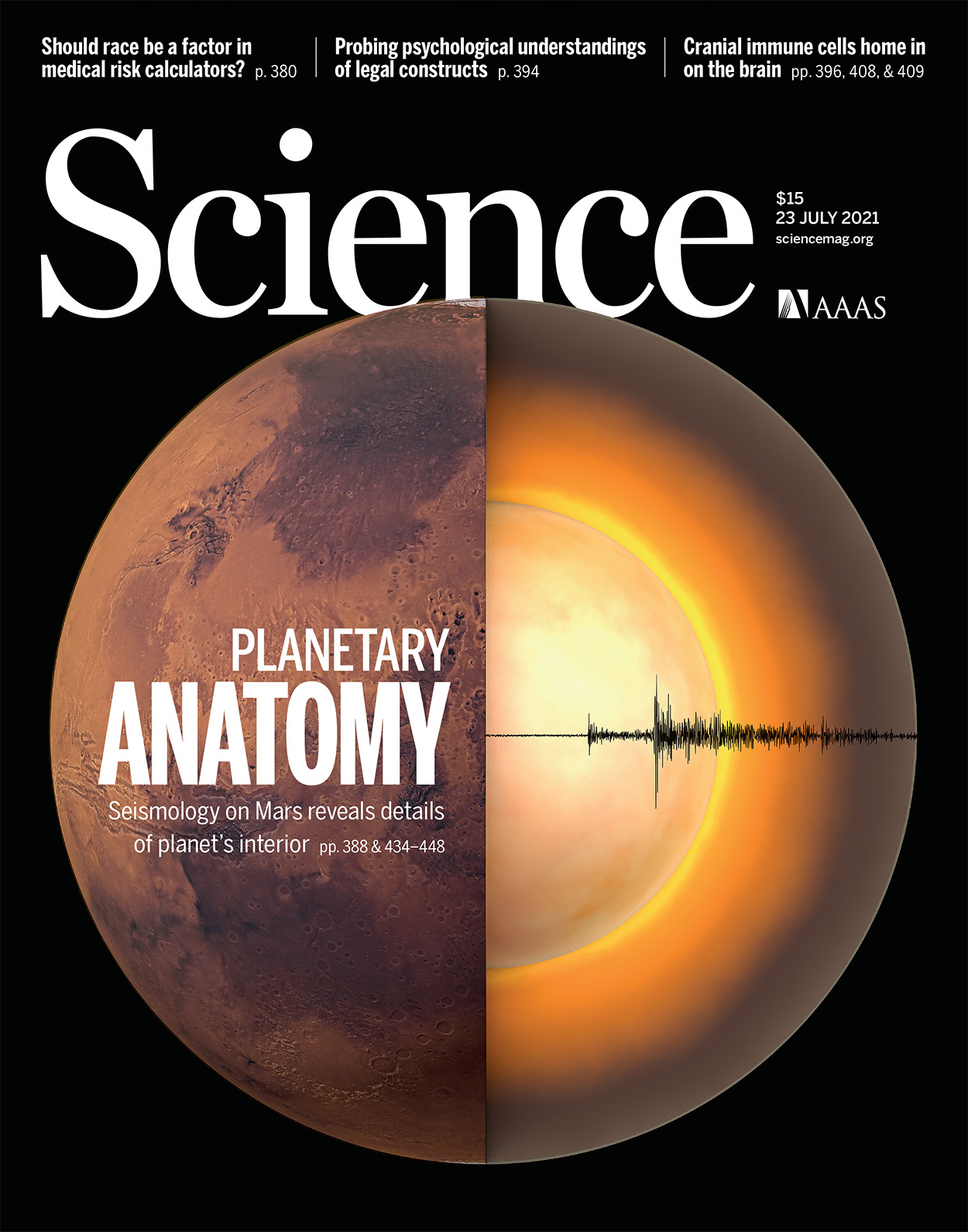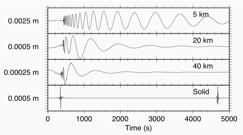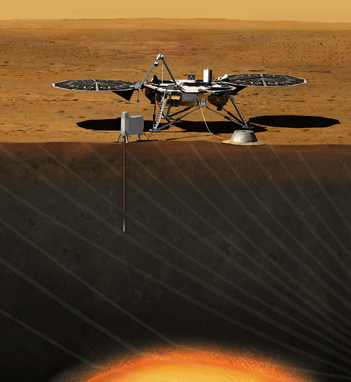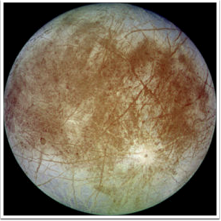Overview
I have interest in planetary seismology anywhere it is feasible to place seismometers in the solar system. To date, this work has focused on Mars, Europa, Titan and our own Moon.
InSight: Interior Exploration using Seismic Investigations, Geodesy and Heat Transport)
Summary
InSight is a mission to Mars, which landed in November, 2018. InSight illuminates the fundamental processes of terrestrial planet formation and evolution by performing the first comprehensive surface-based geophysical investigation of Mars. It has provided key information on the composition and structure of an Earthlike planet that has gone through most of the evolutionary stages of the Earth up to, but not including, plate tectonics. The traces of this history are still contained in the basic parameters of the planet: the size, state and composition of the core, the composition and layering of the mantle, the thickness and layering of the crust, and the thermal flux from the interior. The major results of the mission have been presented in a recent issue of Science magazine, including constraint on the crust, mantle, and core.

Mission objectives on determining Martian interior structure achieved. Image courtesy of Science magazine.
InSight continues to operate on the surface of Mars, despite increasing dust on its solar panels. It recently made it through aphelion (when Mars is farthest from the Sun, thus minimizing solar power while maximizing heating requirements), and continued operation of the broadband seismometer thhroughout, thanks in part to clever solar panel cleaning, which used the lander arm to drop sand near the panel, which was then swept across the panel in the wind and cleaned off dust.
References
S. C. Stähler, A. Khan, W. B. Banerdt, P. Lognonné, D. Giardini, S. Ceylan, M. Drilleau, A. C. Duran, R. F. Garcia, Q. Huang, D. Kim, V. Lekic, H. Samuel, M. Schimmel, N. Schmerr, D. Sollberger, E. Stutzmann, Z. Xu, D. Antonangeli, C. Charalambous, P. M. Davis, J. C. E. Irving, T. Kawamura, M. Knapmeyer, R. Maguire, A. G. Marusiak, M. P. Panning, C. Perrin, A.-C. Plesa, A. Rivoldini, C. Schmelzbach, G. Zenhäusern, E. Beucler, J. F. Clinton, N. Dahmen, M. van Driel, T. Gudkova, A. Horleston, W. T. Pike, M. Plasman, S. E. Smrekar
"Seismic detection of the martian core"
Science, 373, 443-448, 2021. doi: 10.1126/science.abi7730
B. Knapmeyer-Endrun, M. P. Panning, F. Bissig, R. Joshi, A. Khan, D. Kim, V. Lekic, B. Tauzin, S. Tharimena, M. Plasman, N. Compaire, R. F. Garcia, L. Margerin, M. Schimmel, E. Stutzmann, N. Schmerr, E. Bozdag, A.-C. Plesa, M. A. Wieczorek, A. Broquet, D. Antonangeli, S. M. McLennan, H. Samuel, C. Michaut, L. Pan, S. E. Smrekar, C. L. Johnson, N. Brinkman, A. Mittelholz, A. Rivoldini, P. M. Davis, P. Lognonné, B. Pinot, J.-R. Scholz, S. C. Stähler, M. Knapmeyer, M. van Driel, D. Giardini, W. B. Banerdt
"Thickness and structure of the martian crust from InSight seismic data"
Science, 373, 438-443, 2021. doi: 10.1126/science.abf8966
A. Khan, S. Ceylan, M. van Driel, D. Giardini, P. Lognonné, H. Samuel, N. C. Schmerr, S. C. Stähler, A. C. Duran, Q. Huang, D. Kim, A. Broquet, C. Charalambous, J. F. Clinton, P. M. Davis, M. Drilleau, F. Karakostas, V. Lekic, S. M. McLennan, R. R. Maguire, C. Michaut, M. P. Panning, W. T. Pike, B. Pinot, M. Plasman, J.-R. Scholz, R. Widmer-Schnidrig, T. Spohn, S. E. Smrekar, W. B. Banerdt
"Upper Mantle Structure of Mars from Seismic Data"
Science, 373, 434-348, 2021. doi: 10.1126/science.abf2966
W. B. Banerdt, S. E. Smrekar, D. Banfield, D. Giardini, M. P. Golombek, C. L. Johnson, P. Lognonné, A. Spiga, T. Spohn, C. Perrin, S. C. Stähler, D. Antonangeli, S. Asmar, C. Beghein, N. Bowles, E. Bozdag, P. T. Chi, U. Christensen, J. F. Clinton, G. S. Collins, I. Daubar, V. Dehant, M. Drilleau, M. Fillingim, W. Folkner, R. F. Garcia, J. Garvin, J. Grant, M. Grott, J. Grygorczuk, T. Hudson, J. C. E. Irving, G. Kargl, T. Kawamura, S. Kedar, S. King, B. Knapmeyer-Endrun, M. Knapmeyer, M. Lemmon, R. D. Lorenz, J. N. Maki, L. Margerin, S. M. McLennan, C. Michaut, D. Mimoun, A. Mittelholz, A. Mocquet, P. Morgan, N. T. Mueller, N. Murdoch, S. Nagihara, C. Newman, F. Nimmo, M. P. Panning, W. T. Pike, A.-C. Plesa, S. Rodriguez, J. A. Rodriguez-Manfredi, C. T. Russell, N. Schmerr, M. Siegler, S. Stanley, E. Stutzmann, N. Teanby, J. Tromp, M. van Driel, N. Warner, R. C. Weber, and M. Wieczorek
"Initial results from the InSight mission on Mars"
Nature Geoscience, 13, 183-189, 2020. doi: 10.1038/s41561-020-0544-y
M.P. Panning, P. Lognonné, W. B. Banerdt, R. Garcia, M. Golombek, S. Kedar, B. Knapmeyer-Endrun, A. Mocquet, N.A. Teanby, J. Tromp, R. Weber, E. Beucler, J.-F. Blanchette-Guertin, M. Drilleau, T. Gudkova, S. Hempel, A. Khan, V. Lekic, A.-C. Plesa, A. Rivoldini, N. Schmerr, Y, Ruan, O. Verhoeven, C. Gao, U. Christensen, J. Clinton, V. Dehant, D. Giardini, D. Mimoun, W. T. Pike, S. Smrekar, M. Wieczorek, M. Knapmeyer, and J. Wookey,
"Planned products of the Mars Structure Service for the InSight mission to Mars",
M.P. Panning, E. Beucler, M. Drilleau, A. Mocquet, P. Lognonné, and W.B. Banerdt,
"Verifying single-station seismic approaches using Earth-based data: Preparation for data return from the InSight mission to Mars"
Icarus, 248, 230-242, doi: 10.1016/j.icarus.2014.10.035, 2015. pdf of submitted paper
Long-period seismology on Europa
Summary
Europa, one of the Galilean moons of Jupiter, is of great interest to the planetary community, primarily due to evidence of an extensive liquid water ocean below the outer ice shell. Determining the thickness of that ice shell can be accomplished using seismological observations, perhaps even from orbit.

Vertical component seismograms for different ice shell thicknesses and for a model with no liquid ocean.
In order to explore the importance of long period data (periods from 10 to 1000 seconds) in constraining this and deeper structure, we first determined a range of thermodynamically self-consistent models (Paper I published in JGR Planets). These models were then used to predict the seismic response using a normal modes summation method (Paper II).
We conclude that the Rayleigh wave group velocity dispersion, which is marked by a characteristic transition to a flexural mode which depends on ice shell thickness in this frequency band, may be used to determine the ice shell thickness even if the tectonic event can not be located.
References (click for pdf)
The Dragonfly mission to Saturn's moon Titan
I am a co-investigator on the Dragonfly mission to Saturn's moon Titan. This mission will launch in 2027 and deliver a rotorcraft to Titan in the mid-2030s. More info to come!
The Farside Seismic Suite (FSS)
The Farside Seismic Suite (FSS) was selected in 2021 to fly seismic instruments based on the InSight seismic instruments to the farside of the Moon. The instruments will be contained in a package designed to outlive the commercial lander that delivers the instruments and operate day and night for months to measure seismicity on the farside of the Moon for the first time. More info to come!

